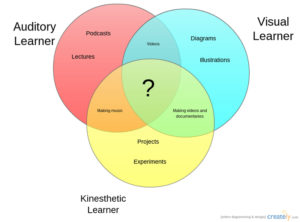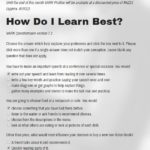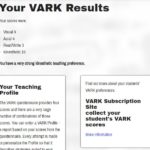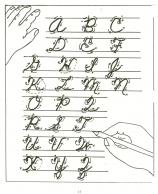 If you use the VARK model of Student Learning, you know why I’m excited about it. VARK started as a questionnaire to help students and teachers understand their best approach to learning but has since become more of a guideline for teaching and learning. The questionnaire is deliberately short (thirteen-sixteen questions, depending upon which version you take) in order to prevent student survey fatigue.
If you use the VARK model of Student Learning, you know why I’m excited about it. VARK started as a questionnaire to help students and teachers understand their best approach to learning but has since become more of a guideline for teaching and learning. The questionnaire is deliberately short (thirteen-sixteen questions, depending upon which version you take) in order to prevent student survey fatigue.
The acronym VARK refers to four learning modalities — Visual, Auditory, Reading/Writing, and Kinesthetic. Though often classroom lessons focus on the Visual, with a bit of preparation, they can be taught using all four modalities thus accommodating students who learn best in a different way. Why go through this extra effort? VARK’s creator, Neil Fleming, explains it this way:
- Students’ preferred learning modes have a significant influence on their behavior and learning.
- Information that is accessed through students’ use of their modality preferences shows an increase in their levels of comprehension, motivation, and metacognition.
For me, that extra time and effort is a no-brainer. Let me back up a moment and explain how I got to that point. I realized after a few years of teaching that something was wrong with the methodology I had been taught. Lots of clever, smart kids weren’t getting what I was putting out. I taught in a way that addressed how the majority learned (because that covered most kids, didn’t it?) but that turned out to be more like a plurality. Or less. In fact, where that plurality of kids might be the biggest group in the class, those that weren’t learning in this prescriptive manner was an even bigger group. To say it another way:
What the Bell Curve considers the “typical student” was always far outnumbered by those who weren’t.
Interestingly enough, Dr. Fleming reports that Kinesthetics (the K in VARK) is the most common learning style though not the most common teaching style.
It was time to shake things up.
Differentiated instruction, also called “personalized learning”, addresses the truism that every student learns differently. How they absorb, process, comprehend, and retain information often doesn’t match how their neighbor does. For example, when I teach coding, some students jump in and learn by doing, not getting frustrated by how many times they must debug, retry, and redo. Others start by reading instructions, watching videos, and observing the work of their neighbor. Still others follow a hybrid of both.
Learning better when information is presented a certain way has nothing to do with intelligence.
Just as someone who can’t see would fail if all instruction were visual, many of us absorb knowledge better when presented in a certain way.
What is VARK?
VARK is a learning style inventory. The acronym refers to the four most-common learning styles — Visual, Auditory, Reading/Writing, and Kinesthetics found within educational theorist Neil Fleming’s model of student learning.
- Visual: information presented as maps, spider diagrams, charts, graphs, flow charts, labeled diagrams, and all the symbolic arrows, circles, hierarchies and other devices that people use to represent what could have been presented in words.
- Auditory/Aural: a preference for information that is heard or spoken such as lectures, group discussion, radio, email, mobile phones, speaking, web-chat and talking things through.
- Reading/Writing: information displayed as words, text-based input and output. This includes all forms but especially manuals, reports, essays, and assignments.
- Kinesthetic: a preference for gathering information through experience and practice, simulated or real, either through concrete personal experiences, examples, practice or simulation. It also includes demonstrations, simulations, videos, and movies, as well as case studies, practice, and applications.
The VARK model acknowledges that students process information differently, referred to as “preferred learning modes”. This has a significant impact on the student’s ability to collect and disseminate information and should be matched with appropriate learning strategies. When that is done properly, students show increased ability to comprehend it, use it, and relate it to other knowledge.
VARK used to be referred to as VAK until Reading/Writing was highlighted as significantly different from the Visual modality.
How do you get started?
Start with an open-minded assessment of the student’s learning style using the VARK questionnaire or one of several other learning style inventories. The goal is to uncover how the student learns best. At the end of the VARK questionnaire, students get a report that analyzes their answers and draws conclusions as to what their best learning style is. Students use these results to understand their preferred modality and in a bigger sense, come to terms with why learning challenges they’ve faced in the past have less to do with their intelligence and more with how the knowledge was presented. Follow up this written report with varied activities from all four modalities and pay close attention to the types of intelligence students display as they complete tasks.
Like students, teachers also have preferred teaching modalities. VARK offers a teacher questionnaire to help teachers understand how they teach. Here’s mine:
Because often teachers don’t understand how to teach using these different modalities, train faculty to not only recognize these learning preferences among their students but to be open-minded about accepting them and be capable of teaching in all.
A note of caution: VARK is intended to start a conversation about options in learning styles that might help students themselves become better learners by thinking more about circumstances that aid or stifle learning. Neil Fleming says:
“[VARK] … is a beginning of a dialogue, not a measure of personality. It should be used strictly for learning, not for recreation or leisure. Some also confuse preferences with ability or strengths. You can like something, but be good at it or not good at it or any point between. VARK tells you about how you like to communicate. It tells you nothing about the quality of that communication.”
When students realize that everyone learns in different ways, Dr. Fleming reports their common reaction is:
“At last I know I’m different not dumb.”
Educational Applications
The idea of individual learning styles is so popular because it makes sense. We see it in action. We notice it in ourselves. Learning-styles theory is endorsed by 93 percent of the public and 76 percent of educators.
Wait — what? 24% of educators don’t think it exists? Here’s how implementing the results of the VARK questionnaire would look in an education ecosystem:
- Teachers understand why students don’t always understand their well-constructed lesson plans.
- Teachers begin to present materials in multiple ways, accepting that students learn in different ways.
- Teachers allow students to complete their work in ways that work for them, as long as what they do satisfies lesson goals.
- When teaching, Gardner recommends two steps: 1) Individualize teaching for students, and 2) pluralize teaching to include as many of the intelligences as possible.
- When teaching keyboarding, teachers play music so students can pace themselves with the beat.
- Instead of checklists, teachers use brainstorming and mindmaps to help students organize their ideas.
Popular Multisensory Teaching Approaches
Once modalities have been identified, there are a variety of approaches available for implementing multisensory teaching. The most common and one often used to teach writing is sand trays. Often these are integrated into a teaching strategy like:
- Gardner’s Multiple Intelligences
- Whole Brain Teaching
- Orton-Gillingham
Gardner’s Multiple Intelligences
In 1983, Howard Gardner published what would become a seminal discussion on what he called a learners’ multiple intelligences and became one of the best-known of the discussions on learning styles. Since then, it has grown to an approach to teaching based on the most common multiple intelligences:
- Linguistic intelligence (“word smart”)
- Logical-mathematical intelligence (“number/reasoning smart”)
- Spatial intelligence (“picture smart”)
- Bodily-Kinesthetic intelligence (“body smart”)
- Musical intelligence (“music smart”)
- Interpersonal intelligence (“people smart”)
- Intrapersonal intelligence (“self smart”)
- Naturalist intelligence (“nature smart”)
Whole Brain Teaching
Whole Brain Teaching (WBT) is a multisensory approach to teaching that includes vocal directions mixed with hand gestures, inflections, full body movement, head motions, and chants. It uses “model and repeat” in a fast-paced class that at first blush, visitors would probably call chaotic. Students call it fun. Parents call it effective. Click for more detail.
Orton-Gillingham
Officially labeled “Orton-Gillingham Multisensory Structured Language Approach”, this teaching style relies on using all the senses — visual, auditory, tactile, and kinesthetic. Where it was first applied to those with reading problems, when O-G was expanded to all classrooms, it excelled. Click here for more detail.
***
Now, after more than a decade of teaching in a manner that addresses student personal learning styles, I can see that the time invested up front quickly paid off in student success. And once I learned to structure lessons that meet students where they learn, it actually saved time in not having to re-explain, provide after-school tutoring, and discuss with them and their parents why they didn’t do well when we all knew they were smart enough.
Have you had a similar experience? Or a different one? I’d love to hear from you.
— image credit: https://youtu.be/Ji38aUS4w2w
— published first on TeachHUB
More on VARK:
The VARK Questionnaire to determine your learning modality
Short introductory videos on VARK
Jacqui Murray has been teaching K-18 technology for 30 years. She is the editor/author of over a hundred tech ed resources including a K-12 technology curriculum, K-8 keyboard curriculum, K-8 Digital Citizenship curriculum. She is an adjunct professor in tech ed, Master Teacher, webmaster for four blogs, an Amazon Vine Voice, CSTA presentation reviewer, freelance journalist on tech ed topics, contributor to NEA Today, and author of the tech thrillers, To Hunt a Sub and Twenty-four Days. You can find her resources at Structured Learning.








































3 thoughts on “What is the VARK model of Student Learning?”
Comments are closed.